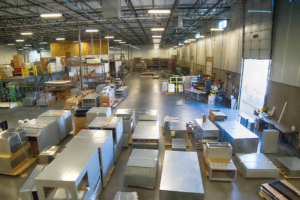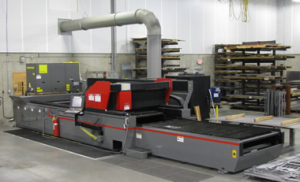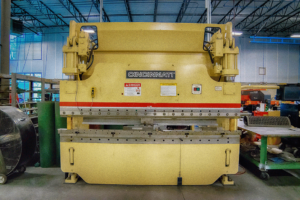 Metal fabrication is a process in which machines and structures are designed from raw materials. Common raw materials that fabricators use include plate and sheet metal; expanded and formed metal; and sectional metals. The list of assorted hardware includes square and tube stock; welding wire; fittings; and castings. Common types of metal used for fabrication include stainless steel, steel, and aluminum, as well as other forms of non-ferrous components. Some examples of metal fabrication products would be building electrical equipment or utility products such as termination cabinets and CT cabinets. There are three basic processes of metal fabrication.
Metal fabrication is a process in which machines and structures are designed from raw materials. Common raw materials that fabricators use include plate and sheet metal; expanded and formed metal; and sectional metals. The list of assorted hardware includes square and tube stock; welding wire; fittings; and castings. Common types of metal used for fabrication include stainless steel, steel, and aluminum, as well as other forms of non-ferrous components. Some examples of metal fabrication products would be building electrical equipment or utility products such as termination cabinets and CT cabinets. There are three basic processes of metal fabrication.
Metal Cutting

The raw materials mentioned above must be cut for proper sizing. Shearing or metalworking is the most commonly used method of cutting. Cutting also is performed by sawing and/or welding with hand held plasma or oxy- acetylene torches. Cutting torches are used for large pieces of sheet metal, because they require very little effort.
Specialized band saws have been designed for cutting these and have a feed mechanism with hardened blades, allowing for an even finish. Chop saws, or abrasive cut off saws, resemble miter saws; however, these have steel cutting abrasive disks. Laser cutters for structural steel fabrication, which uses laser and plasma cutters, rotates the head around the material in three dimensions via robots.
CNC, or numerical control cutters, are also used for this process by utilizing a mill bit; laser; water jet; or torch. CNC cutting torches or burn tables are generally gas powered. The plate steel is fed onto a table and parts are cut via software that has been programed. A grid of bars, which is replaceable, creates the support table. More expensive versions include the ability to punch, as well as a carousel, and consist of different taps and punches.
CNC Bending

Metal fabrication requires bending or forming, which is performed by powered or manual hammering, press brakes, and other such tools. Forming metal is done by applying great force to the object. This can be accomplished by way of tools; such as dies or punches. The machinery is used to control direction and force magnitude as well.
Fabricators use press brakes to air, bend or coin and form sheet metal. CNC operated back gauges require hard stops for positioning cut parts and place bend lines into the appropriate position. The addition of off line software has made programing CNC press brakes extremely efficient.
Fabrication and Assembling
Pieces are assembled through binding with adhesives, welding, threaded fasteners, and riveting, as well additional bending to form a crimp seam. Welding flux, wire, and/or fasteners is used to join the cut pieces of sheet metal. This process requires both automaton and human manual labor.
 In most cases, MIG and/or TIG welders are used to assemble the fabricated metal components according to the engineers’ schematics. There are certain precautions used to prevent the weldment from warping, due to excessive heat. This sometimes includes a redesign of the weldment. The welder may use a smaller amount of weld. It may be welded in a staggering fashion or using a stout fixture. The weldment may also be covered in sand during the cooling process, or straightening operations may be performed once welding is complete.
In most cases, MIG and/or TIG welders are used to assemble the fabricated metal components according to the engineers’ schematics. There are certain precautions used to prevent the weldment from warping, due to excessive heat. This sometimes includes a redesign of the weldment. The welder may use a smaller amount of weld. It may be welded in a staggering fashion or using a stout fixture. The weldment may also be covered in sand during the cooling process, or straightening operations may be performed once welding is complete.
The final assembly cannot begin until the weldments have cooled. This final stage generally consists of end structures being sand blasted, primed, and then, finally, painted in the Powder coating and Finishing Stage. If any additional machining has been specified, it is now completed. Some other styles of metalworking are known as machining, stamping, casting, and forging. These are similar processes; however, these are not usually classified as metal fabrication.